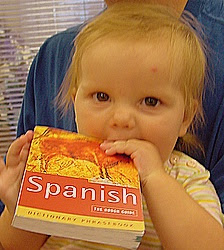The 22 important tasks for easy Spanish
 |
| You’d better be obsessed with Spanish Photo credit: gthills licensed CC BY-SA 2.0 |
- During the initial phase of your Spanish-learning program, just try to listen to Spanish as much as possible. This is essential for you if you wish to develop an ear for Spanish. Listen to radio broadcasts and podcasts in Spanish and there are many available for free just for you!
- Develop a deeply-rooted desire, a compulsion, or even better, an obsession to learn Spanish. Without an obsession, you are not likely to get too far. Lack of a compulsive desire to master the language is, by far, the biggest reason behind people quitting their Spanish programs half-way through.
- Maximize the utilization of time otherwise wasted, in learning Spanish. Every time you find yourself waiting at the doctor’s office, standing in that line, waiting for the elevator, or lying sleepless in bed, treat that free time as a window of opportunity that mustn’t be wasted.
- Never learn individual words off a dictionary. Always think and read in context. Learn phrases instead of words. It’s always easier, more practical, and more thorough to learn the Spanish for, say, “I am going to the bank”, instead of the Spanish for each words individually. This helps you absorb subtle grammar too.
- Visualize. Use your imagination as far as practically possible. Human brain retains wholesome imageries better than written words and sentences. Lifeless vocabulary and dead-beat grammar, when augmented with pictures and sounds tend to come alive and stay in your active memory for longer.
- Create stories and write them out in Spanish as much as possible. Use native language for words whose Spanish is still unknown and look them up later. Then write the same story again. Repeat this until perfection.
- Watch videos and original programming in Spanish. Youtube® is a massive reservoir of free resources of this kind and there are many more available on the Internet. LoMasTV® is another promising resource solely aimed at people who are learning Spanish.
- Use flashcards, physical or virtual (e.g., Anki®) depending on your preferences, to review and consolidate newly acquired vocabulary. Again, use phrases or sentences instead of words for reasons stated earlier.
- Use exotic mnemonics or other visual aids to learn and retain new Spanish vocabulary or concepts. The sillier your mnemonic, the better for retention. The more it stands out, the better it stays in!
- Browse through a Spanish-English-Spanish dictionary as often as possible. Do not make a deliberate attempt to memorize words off the dictionary. Just browse and let interesting phrases drive home naturally. Pay more attention to the example phrases than the words themselves.
- Draw two columns in a notebook and list out phrases, those in your native language on the right and the Spanish equivalent on the left. This is another memory aid that functions in a fashion not much different from flashcards.
- Pick an extremely primitive kids’ story book (fairy tales or fables), and try translating it into Spanish. Be creative and use your imagination to improvise on the original plot. Make it as funny and silly as possible utilizing your knowledge of Spanish and a limited vocabulary.
- This one is interesting and we are not sure of the rationale behind this tip in learning Spanish but they say it works anyway: Learn the past tense before learning the present and the latter before the future tense. Maybe because that’s the natural order of events? One seriously wouldn’t know but it surely looks like a harmless experiment nonetheless.
- Pick unfamiliar Spanish sounds and practice them while driving or taking a shower, or whenever you find yourself alone doing something mundane. An example could be the notorious “rr” sound of Spanish!
- Use free online resources for not only learning Spanish but also learning interesting things about the culture of places where Spanish is spoken. Develop an affinity for the Latino lifestyle and culture.
- You must have read several books and stories in your native language before. Now, try reading them in Spanish. Use a dictionary if you need but don’t revert to your native language, come whatever may.
- Read comics and graphic novels in Spanish.
- Try thinking in Spanish instead of first thinking in English and then translating your thoughts into Spanish before speaking.
- Read Spanish grammar. Yes, it is true that we always encourage you to stay away from memorizing those regimented rules of grammar like the plague but reading them is another story altogether. Just browse through that Spanish grammar tome without dwelling on any rule or memorizing it. Whatever is relevent or important will automatically stick to ur brain. Don’t do anything more than just frequently scanning the book.
- Label most household items with their names in Spanish.
The 2 “most important” tasks for easy Spanish!
- Make mistakes without regret or remorse.
- Take a very short break every once in a while just to cool it off and to allow all that Spanish to sink in.
















0 comments:
Post a Comment